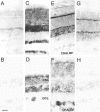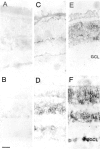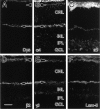Laminin expression in adult and developing retinae: evidence of two novel CNS laminins
- PMID: 10964957
- PMCID: PMC2924637
- DOI: 10.1523/JNEUROSCI.20-17-06517.2000
Laminin expression in adult and developing retinae: evidence of two novel CNS laminins
Abstract
Components of the extracellular matrix exert myriad effects on tissues throughout the body. In particular, the laminins, a family of heterotrimeric extracellular glycoproteins, have been shown to affect tissue development and integrity in such diverse organs as the kidney, lung, skin, and nervous system. Of these, we have focused on the roles that laminins play in the differentiation and maintenance of the nervous system. Here, we examine the expression of all known laminin chains within one component of the CNS, the retina. We find seven laminin chains-alpha3, alpha4, alpha5, beta2, beta3, gamma2, and gamma3-outside the retinal basement membranes. Anatomically, these chains are coexpressed in one or both of two locations: the matrix surrounding photoreceptors and the first synaptic layer where photoreceptors synapse with retinal interneurons. Biochemically, four of these chains are coisolated from retinal extracts in two independent complexes, confirming that two novel heterotrimers-alpha4beta2gamma3 and alpha5beta2gamma3-are present in the retinal matrix. During development, all four of these chains, along with components of laminin 5 (the alpha3, beta3, and gamma2 chains) are also expressed at sites at which they could exert important effects on photoreceptor development. Together, these data suggest the existence of two novel laminin heterotrimers in the CNS, which we term here laminin 14 (composed of the alpha4, beta2, and gamma3 chains) and laminin 15 (composed of the alpha5, beta2, and gamma3 chains), and lead us to hypothesize that these laminins, along with laminin 5, may play roles in photoreceptor production, stability, and synaptic organization.
Figures













References
-
- Anton ES, Sandrock AW, Jr, Matthew WD. Merosin promotes neurite growth and Schwann cell migration in vitro and nerve regeneration in vivo: evidence using an antibody to merosin, ARM-1. Dev Biol. 1994;164:133–146. - PubMed
-
- Arahata K, Ishii H, Hayashi YK. Congenital muscular dystrophies. Curr Opin Neurol. 1995;8:385–390. - PubMed
-
- Burgeson RE, Chiquet M, Deutzmann R, Ekblom P, Engel J, Kleinman H, Martin GR, Meneguzzi G, Paulsson M, Sanes J, Timpl R, Tryggvason K, Yamada Y, Yurchenco PD. A new nomenclature for the laminins. Matrix Biol. 1994;14:209–211. - PubMed
-
- Chait BT, Kent SB. Weighing naked proteins: practical, high-accuracy mass measurement of peptides and proteins. Science. 1992;257:1885–1894. - PubMed
Publication types
MeSH terms
Substances
Grants and funding
LinkOut - more resources
Full Text Sources
Other Literature Sources
Molecular Biology Databases
